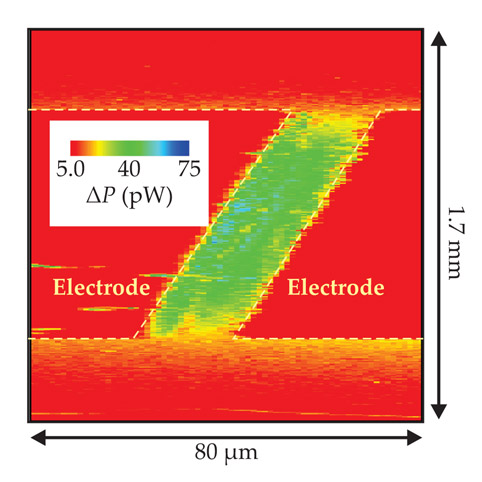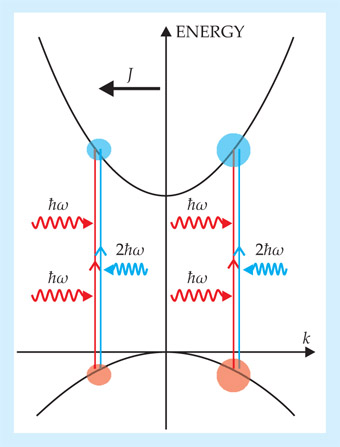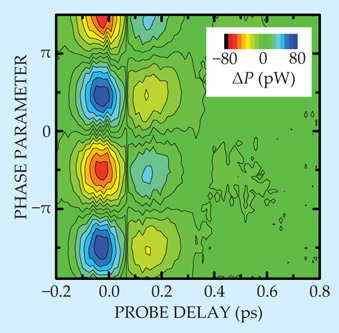Frequency-doubled photons can measure current density
DOI: 10.1063/PT.3.1461
The field of nonlinear optics was born in 1961, when Peter Franken and colleagues at the University of Michigan shot red light at a quartz crystal and measured near-UV light exiting out the back. 1 Within a year a team of scientists at the Ford Motor Co had experimentally demonstrated that frequency doubling, or second-harmonic generation (SHG), could be induced by an externally applied electric field. 2 Nowadays, physicists routinely use SHG to measure electric fields in semiconductor devices. The fields serve to diagnose any number of properties—for example, how ambient oxygen affects the ability of a thin silicon oxide layer to trap electrons.
Johns Hopkins University theorist Jacob Khurgin began to compose a variation on the field-as-diagnostic theme in 1995, when he calculated that electric current also can induce SHG. 3 As a consequence, he predicted, it should be possible to probe the current in a semiconductor via a measurement of its outgoing frequency-doubled light. Khurgin’s principal result was confirmed in 2009, when Oleg Aktsipetrov (Moscow State University) and colleagues measured the frequency-doubled light generated when light bounces off a current-carrying silicon crystal. 4 The Aktsipetrov group, though, did not map out current density in detail. That challenge has now been realized by Hui Zhao (University of Kansas), his student Brian Ruzicka, and an international team that includes Khurgin. 5 Their methods, says Zhao, should enable current-based diagnostics that complement present techniques relying on field-induced SHG.
Current thinking
In their simplest experiment, Zhao and colleagues mapped the direct current flowing through a room-temperature gallium arsenide sample to which two gold electrodes had been affixed. The first step was to establish, as theoretically expected and independently seen by Aktsipetrov and company, that the power in frequency-doubled light is proportional to current density. To do that, they passed known currents across the electrodes and interrogated the sample with a pulsed 1800-nm laser beam polarized in the direction of the current. The interrogating beam was focused on a 4-µm-diameter spot between the electrodes, and the transmitted 900-nm light was detected with a silicon photodiode.
Current was not the only source of the observed frequency-doubled light. Like quartz, GaAs crystals can intrinsically induce SHG. The Kansas researchers, in essence, measured the power in 900-nm light with and without current flow and confirmed that the difference is proportional to current density. Once that linear relation was established, they could map out current by scanning the laser focus across the GaAs sample.
Figure 1 shows the result. The green swath gives the power at 900 nm due to the current flowing left to right between the electrodes. Although the direct current measured by Zhao and colleagues is accompanied by an Ohm’s-law electric field that itself generates frequency doubling, theoretical considerations show that the observed frequency doubling is indeed current induced, not field induced. Moreover, the researchers followed their DC experiment with one in which frequency-doubled radiation measured an oscillating current created via a procedure called coherent current injection. That technique exploits quantum interference to produce current without requiring any external electric field.

Figure 1. The power ΔP in frequency-doubled light serves as a measure of the current density in a semiconductor. In this image, the green area identifies the current flowing between two gold electrodes affixed atop a gallium arsenide crystal. The red background is a consequence of electronic noise and stray light. (Adapted from ref.

You can’t go Ohm again
In coherent current injection, two indistinguishable processes promote electrons from the valence to the conduction band; figure 2 sketches the idea. One process involves the absorption of a single laser photon at frequency 2ω; the second requires that two laser photons at frequency ω be absorbed. The quantum amplitude for the promotion is a sum of the amplitudes for the two individual processes. The probability, therefore, includes an interference term, which depends on the momentum of the electron being promoted and also on a phase parameter, the phase of the beam at 2ω minus twice the phase of the beam at ω.

Figure 2. Coherent current injection relies on the interference between two processes that promote electrons to the conduction band. One involves the absorption of a single photon with an energy 2ℏω, sufficient to promote the electron; the second requires the absorption of two photons with half that energy. When laser beams providing the photons are suitably out of phase, electrons with positive momentum ℏk are preferentially promoted, as schematically indicated by the larger filled circles on the right. As a result, current density J flows in the negative direction. (Adapted from ref.

When the phase parameter is zero, electrons with momentum ℏk and those with momentum −ℏk are promoted with equal likelihood; no current flows. But as Zhao and colleagues change the phase parameter by adjusting the relative path length of their two pumping laser beams, they alternate between preferentially promoting electrons with positive momentum (leaving holes with negative momentum) and promoting electrons with negative momentum. In either case, the nontrivial phase relations lead to the initiation of a net current parallel to the polarization of the pumping lasers.
Once electrons and holes are injected with opposite momenta, they begin to separate. But Coulomb attraction decelerates them, stops them, and draws them together. The result is a rapidly oscillating plasma current, strongly damped because the charge flow occurs in a material medium. To measure it, Zhao and company observed the enhanced power in the frequency-doubled light, essentially just as they did in the DC case. In this more dynamic context, however, they did not map out current density as a function of position. Rather, they focused the interrogating laser beam on a fixed, 2.1-µm-diameter spot on the GaAs sample, but varied the time interval separating the injection of current by the pump lasers and the observation of SHG triggered by the interrogating laser. As figure 3 shows, the researchers observed a plasma oscillation period of about 0.4 ps (a half-cycle is readily apparent). Follow-up trials established that the oscillation amplitude depends on the angle between the current and the interrogating beam’s polarization; it’s greatest when the two are parallel. If the direction of current flow is unknown, one can determine it by finding the polarization that gives the maximum power in frequency-doubled light.

Figure 3. Current oscillations reveal themselves by the frequency-doubled light they induce. In this plot, the phase parameter, as described in the text, determines the initial amplitude and direction of the current. For a fixed phase, the current-induced power ΔP in frequency-doubled light oscillates as a function of time between current injection and second-harmonic generation. Both the lasers that inject current and the laser that triggers SHG have finite pulse widths. For that reason, current is observed even before the nominal injection time t = 0. (Adapted from ref.

Admittedly, the separated electrons and holes affect the other charges in the GaAs, and so the sample is permeated with an electric field capable of inducing SHG. Intuitively, though, one might expect that the internal electric field would lag behind the inducing current. And indeed, experiments show the lag to be about a quarter period. The observed coincidence of current injection and maximum power in frequency-doubled light demonstrates that the SHG is induced by the current rather than by the field.
The 50-fs time resolution already achieved by his group, says Zhao, is superior to that of other current-measuring techniques and should enable studies of transient electron transport in graphene, carbon nanotubes, and other nanomaterials too small to support steady currents. Moreover, it can easily be improved with the help of shorter-pulsed lasers. Near-field optics may enable the team to improve its spatial resolution from 2 µm to about 100 nm. Even that superior resolution is not as good as could be obtained with, for example, electron microscopy. But current measurements via SHG and coherent current injection allow for the study of samples in situ. There’s no need to alter them by attaching electrodes or to destroy them with high-energy electrons.
References
1. P. A. Franken et al., Phys. Rev. Lett. 7, 118 (1961). https://doi.org/10.1103/PhysRevLett.7.118
2. R. W. Terhune, P. D. Maker, C. M. Savage, Phys. Rev. Lett. 8, 404 (1962). https://doi.org/10.1103/PhysRevLett.8.404
3. J. B. Khurgin, Appl. Phys. Lett. 67, 1113 (1995). https://doi.org/10.1063/1.114978
4. O. A. Aktsipetrov et al., JETP Lett. 89, 58 (2009). https://doi.org/10.1134/S0021364009020027
5. B. A. Ruzicka, et al., Phys. Rev. Lett. 108, 077403 (2012).https://doi.org/10.1103/PhysRevLett.108.0774038




